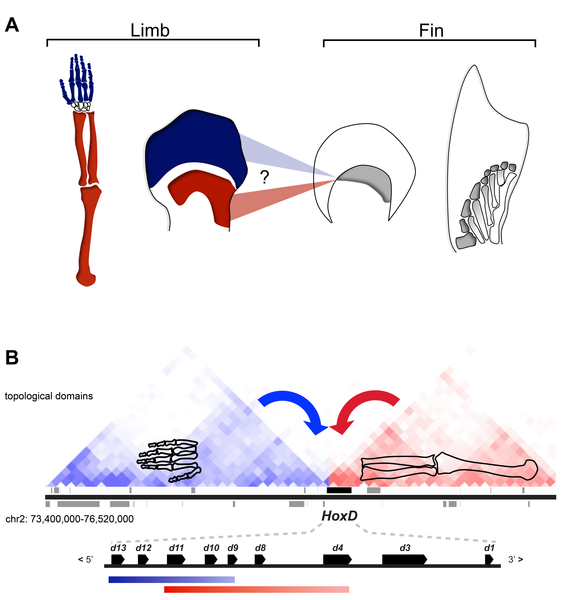How did we get limbs from ancestral fish fins? It's a fascinating topic, a science enigma.
Our first four-legged land ancestor came out of the sea about 350 million years ago. Watching a lungfish, our closest living fish relative, crawl on its four pointed fins gives us an idea of what the first evolutionary steps on land may have looked like. However, the transitional path between fin structural elements in fish and limbs in tetrapods remains elusive.
Both fish and land animals possess clusters of Hoxa and Hoxd genes, which are necessary for both fin and limb formation during embryonic development. A team recently compared the structure and behavior of these gene clusters in embryos from mice and zebrafish. The researchers discovered similar 3-dimensional DNA organization of the fish and mouse clusters, which indicates that the main mechanism used to pattern tetrapod limbs was already present in fish. However, when inserted into transgenic mouse embryos, the fish Hox genes were only active in the mouse arm but not in the digits, showing that the fish DNA lacks essential genetic elements for digit formation.
The study concludes that, although the digital part of the limbs evolved as a novelty in land animals, this happened by elaborating on an ancestral, pre-existing DNA infrastructure.

Regulatory mechanisms and the homology conundrum between fins and limbs. (A) The evolutionary changes that occurred during the transition from fins to limbs are mostly unresolved, in particular concerning the most distal segment of tetrapod limbs: the digits. Mammalian proximal and distal limb regions develop along with independent phases of Hoxd expression [indicated in red (arm) and blue (digits)] and fish fin buds have been probed for the existence of similar Hoxd expression patterns. A single expression domain of 5′ Hoxd genes along the distal fin margin (in grey) was interpreted either as corresponding to the distal phase in tetrapods or, alternatively, as homologous to the proximal phase [1],[15],[16],[20],[25]. Accordingly, radials (in grey) could be homologous with digits or this homology may not exist, in which case digits are tetrapod novelties. (B) Proximal (red) and distal (blue) Hoxd gene expression domains in the developing mouse limb are derived from enhancers located within distinct 3′- (red) and 5′- (blue) regulatory landscapes. The enhancer–promoter interaction profiles within these two landscapes were shown to precisely match two topological domains [31] as determined by Hi-C using ES cells [32]. This bimodal regulatory organization in tetrapods suggests distinct evolutionary trajectories for proximal and distal limbs. The presence or absence of such a modular regulatory strategy in fish would help clarify the origin of this mechanism and the homology between fins and limbs. The DNA domain shown is approximately 3 mb large. Credit: doi:10.1371/journal.pbio.1001773
An ancestral regulatory strategy …
A recent study found that, during mammalian development, Hoxd genes depend on a 'bimodal' 3-dimensional DNA structure to direct the development of the characteristic subdivision of the limbs into arm and paw, a division which is absent from fish fins.
"To determine where the genetics behind this subdivision into 'hand' and 'arm' came from during evolution, we decided to closely compare the genetic processes at work in both fin and limb development," says Joost Woltering, researcher at the Department of Genetics and Evolution of the UNIGE Faculty of Science and lead author of the study. Surprisingly, the researchers found a similar bimodal 3-dimensional chromatin architecture in the Hoxd gene region in zebrafish embryos. These findings indicate that the regulatory mechanism used to pattern tetrapod limbs probably predates the divergence between fish and tetrapods. "In fact this finding was a great surprise as we expected that this 'bimodal' DNA conformation was exactly what would make all the difference in the genetics for making limbs or making fins" adds Woltering.
…that just needs to be modernized
Does this imply that digits are homologous to distal fin structures in fish? To answer this question, the geneticists inserted into mice embryos the genomic regions that regulate Hox gene expression in fish fins. 'As another surprise, regulatory regions from fish triggered
Hox gene expression predominantly in the arm and not in the digits. Altogether, this suggests that our digits evolved during the fin to limb transition by modernizing an already existing regulatory mechanism', explains Denis Duboule.
"A good metaphor for what has probably happened would be the process of 'retrofitting', as is done in engineering to equip outdated machine frames with new technology. Only, in this case, it was a primitive DNA architecture which evolved new 'technology' to make the fingers and toes," says Woltering.

The expression of fish Hox genes in a mouse embryo. Credit: Denis Duboule, UNIGE
Fin radials are not homologous to tetrapod digits
The researchers conclude that, although fish possess the Hox regulatory toolkit to produce digits, this potential is not utilized as it is in tetrapods. Therefore, they propose that fin radials, the bony elements of fins, are not homologous to tetrapod digits, although they rely in part on a shared regulatory strategy.
New lines of investigation are to find out exactly what has changed between the DNA elements in fish and tetrapods. 'By now we know a lot of genetic switches in mice that drive Hox expression in the digits. It is key to find out exactly how these processes work nowadays to understand what made digits appear and favor the colonization of the terrestrial environment', concludes Denis Duboule.






Comments